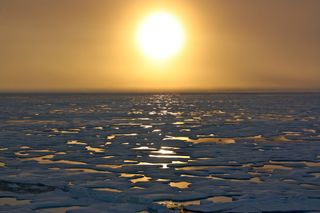Happy Summer Solstice! How to Watch the Season Change Online

Today marks the official start of summer in the Northern Hemisphere, and viewers around the world can ring in the new season with a special online webcast to mark the event.
The Slooh Space Camera, which broadcasts live views from various telescopes around the world, is hosting a special webcast today (June 20) at 7 p.m. EDT (4 p.m. PDT; 2300 GMT) to celebrate the summer solstice, and to examine the sun's recent activity.
The webcast can be accessed by visiting the Slooh Space Camera's website.
The northern summer solstice will occur at 7:09 p.m. EDT (2309 GMT), when the sun reaches the peak of its journey northward and begins moving south again.
During their broadcast, Slooh will feature two live feeds from the Prescott Observatory in Arizona. Commentary will be provided by astronomer Bob Berman, a columnist at Astronomy Magazine and Matt Francis from the Prescott Observatory, according to organizers of the online event.
The webcast will also take a closer look at recent solar storm events in the lead up to the summer solstice.
An active region on the sun, called AR 1504, fired off two M-class, or medium-strength, solar flares last week, hurling two coronal mass ejections toward Earth. These eruptions triggered geomagnetic storms over the weekend, as the plasma and charged particles interacted with Earth's magnetosphere.
Get the Space.com Newsletter
Breaking space news, the latest updates on rocket launches, skywatching events and more!
No adverse effects were reported on Earth from the weekend geomagnetic storms, but the amped up solar activity did supercharge normal displays of the northern lights. Stargazers in states as low as Iowa, Nebraska and Maryland were treated to stunning aurora displays, according to NASA officials.
The summer solstice marks the time when the sun arrives at its northernmost point in the sky. This celestial positioning kicks off summer in the Northern Hemisphere and winter in the Southern Hemisphere.
Follow SPACE.com on Twitter @Spacedotcom. We're also on Facebook and Google+.
Join our Space Forums to keep talking space on the latest missions, night sky and more! And if you have a news tip, correction or comment, let us know at: community@space.com.

Space.com is the premier source of space exploration, innovation and astronomy news, chronicling (and celebrating) humanity's ongoing expansion across the final frontier. Originally founded in 1999, Space.com is, and always has been, the passion of writers and editors who are space fans and also trained journalists. Our current news team consists of Editor-in-Chief Tariq Malik; Editor Hanneke Weitering, Senior Space Writer Mike Wall; Senior Writer Meghan Bartels; Senior Writer Chelsea Gohd, Senior Writer Tereza Pultarova and Staff Writer Alexander Cox, focusing on e-commerce. Senior Producer Steve Spaleta oversees our space videos, with Diana Whitcroft as our Social Media Editor.
